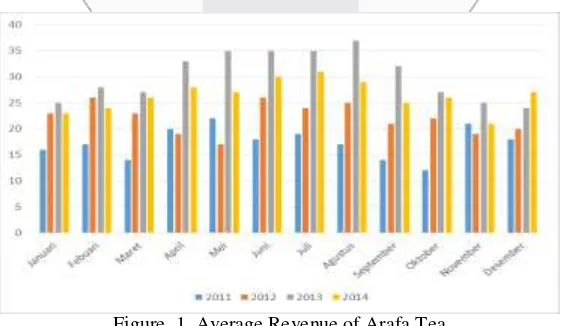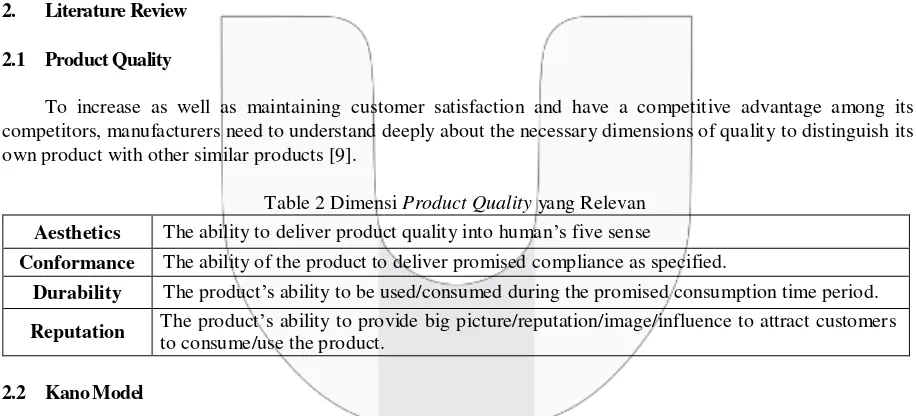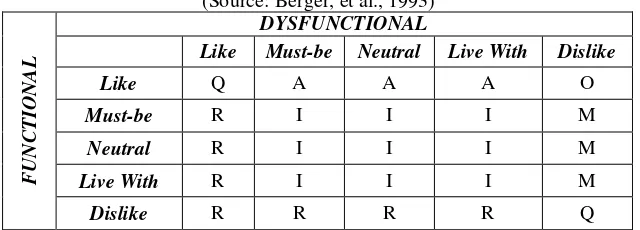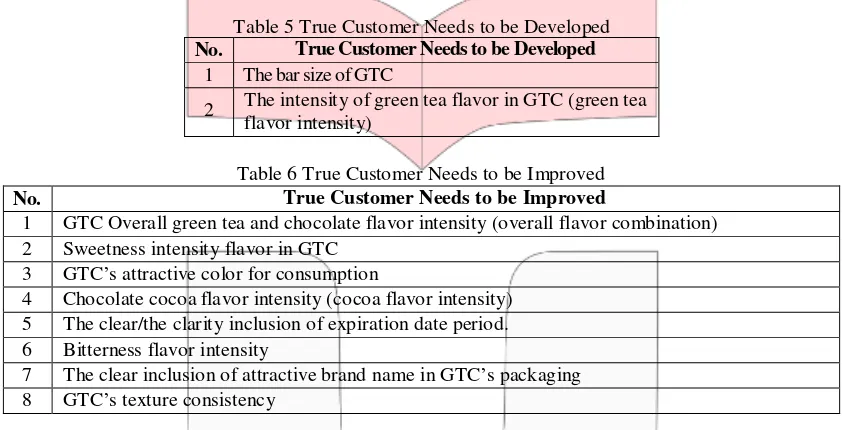Rp40,000,000
Rp30,000,000
Rp20,000,000
Rp10,000,000
Rp0
2011 2012 2013 2014
FORMULATION DESIGN OF GREEN TEA CHOCOLA
TE’S
PRODUCT
DEVELOPMENT USING INTEGRATION OF PRODUCT QUALITY AND KANO
MODEL IN ARAFA TEA
Annisaa Rasyida1, Yati Rohayati2 Atya Nur Aisha3
1,2Prodi S1 Teknik Industri, Fakultas Rekayasa Industri, Telkom University
, 2[email protected], [email protected]
Abstract
Arafa Tea is one of SMEs in Bandung that engaging in tea specialty, with Green Tea Chocolate (GTC) as
its excellent product. GTC’s income has the largest contribution in revenue and has the most rapid
turnover compared with others. Seeing this opportunity, Arafa Tea intends to expand its developed market by positioning GTC as specialty snack from Bandung. The study was conducted using integration of Product Quality and Kano Model to determine the needs and customer satisfaction of GTC. This study generated true customer needs output that should be improved by Arafa Tea. There are 21 attributes used as customer requirement attributes to measure the performance of GTC and categorized them based on the given satisfaction impact. The result shows ten true customer needs attributes with weak satisfaction value, including three attractive, five must-be and two one-dimensional attributes. All attributes are
analyzed and adjusted according Arafa Tea’s ability to obtain the final recommendation of true customer
needs. The analysis shows eight true customer needs, including higher intensity cocoa flavor, flavors combination suitability, higher sweetness intensity, attractive green color, lower green tea intensity, clear
inclusion of expiration date period, lower bitterness intensity and clear inclusion of attractive brand’s name
in packaging.
Keywords: customer satisfaction, product quality, kano model
1. Introduction
Arafa Tea is one of many SMEs that are located in Bandung. Arafa Tea is focusing on variety of processed tea
products, one of which is Green Tea Chocolate (GTC) Arafa Tea. At this point, the selling focus of Arafa Tea is
GTC. This focus is motivated by the consideration that GTC is the most easily consumed products and has the most rapid turnover compared with their other processed tea as well as its developed market especially in the rising trend of green tea flavored snacks among young adults and tourists in the city of Bandung.
The interview with one of the production staff of Arafa Tea mentioned that GTC contributes almost 50% of the overall turnover obtained by Arafa Tea, but only 20% of its revenue comes from the third level of GTC Arafa Tea [1]. The overall revenue obtained by Arafa Tea during the last four years is illustrated in Figure I.
Figure 1. Average Revenue of Arafa Tea
To do this, Arafa Tea need to know the wants and needs of customers regarding GTC. Depth interviews were conducted
as a preliminary survey method to obtain responses about GTC. The survey results showed that 47% respondents didn’t like
GTC. The following Table I is the complaints information that affecting the respondents’ dislike of GTC.
Table 1 Customer’s Complaints
No. Complaints Percentage
1. Taste too bitter and the combinations of each flavors are not fused as a whole. 50%
2. Rough texture and lack of density textures 29%
3. Unattractive green color 7%
4. The bar size is too small 14%
The complaints shown in Table I is a reflection of the unfulfilled expectations of the customers that the underlying presence of dissatisfaction could exist in GTC Arafa Tea.. Therefore, in order for GTC to remain competitive and superior, it
requires customer requirement attributes identification so that GTC are in lined with customers’ expectations and satisfy its
customers.
One way to identify the customer requirement attributes is to use the integration of Product Quality and Kano Model. It refers to a previous similar study that explained that the Kano Model is a method that can be used to determine customer
preferences by categorizing the goods or services’ attributes based on its ability to satisfy the customers by classifying it into
Kano’s category [2]. Kano Model used a structured questionnaire regarding the classification of the product attributes to obtain
the attributes classification based on its level of satisfaction [3]. Kano Model itself is fit with the relevance of the research that aims to develop a product, for which this kind of research has been done previously by Matzler & Hinterhuber [4]. Kano Model offers a very good understanding of how customers evaluate the product and help the company to better focus on important attributes that should be improved [5], could be referred as company's business plan and product development towards innovation, competitiveness and market adjustment of products which increasingly have more options and become more demanding than ever before [6] [7]. The integration is used to obtain the priority of product attributes that need to be developed or improved [8].
2. Literature Review
2.1 Product Quality
To increase as well as maintaining customer satisfaction and have a competitive advantage among its competitors, manufacturers need to understand deeply about the necessary dimensions of quality to distinguish its own product with other similar products [9].
Table 2 Dimensi Product Quality yang Relevan
Aesthetics The ability to deliver product quality into human’s five sense
Conformance The ability of the product to deliver promised compliance as specified.
Durability The product’s ability to be used/consumed during the promised consumption time period.
Reputation The product’s ability to provide big picture/reputation/image/influence to attract customers
to consume/use the product.
2.2 Kano Model
Product attributes that are important to customers can be seen with the aid of Kano Model. Before modeling the attributes, Kano Model involves a process of preliminary studies, the development and then the calculation process or Kano Model questionnaire interpretation. The calculation is done according to Kano Model evaluation table which describes three basic categories and three additional categories, namely [10]:
1. Must Be
An attribute that must be met. If this attribute is not found in the product, customer satisfaction will decrease. But if it isnt, customer will feel nothing (normal). In general, these attributes associated with the basic functions of a product.
2. One Dimensional
3. Attractive
If this attribute is met then the customer satisfaction will increase and if it is not then the customer satisfaction will stay the same as is. This attribute is related to the differentiation of products, so if customers find these attributes contained in a product, the customer will pay more for the existence of this attribute.
4. Indifferent
The presence or absence of this attribute has no effect on customer satisfaction. This attribute is usually found on additional functionality that is of no use at all to the product.
5. Reverse
If it is found in a product, the customer satisfaction will be decreasing. In contrast, if this attribute does not exist, then it can increase the customer satisfaction.
6. Questionable
This attribute indicates a need that cannot be translated clearly and correctly due to a mismatch between the question and the given answer causing wrong response.
3. Research Methods
3.1 Conceptual Model
This study was conducted to determine the categorization of customer requirement attributes for GTC Arafa Tea and sorting the identified attributes into true customer needs. Data and information on the attributes of customer requirement are categorized based on their importance to the dimensions of Product Quality. Conceptual model is drawn in order to describe the relationship between the used variable in the study as illustrated in Figure 2.
X1
Figure 2 Conceptual Model Figure 3 Product Quality Model
Customer Requirement Attribute Code
GTC’s texture has resistance to be bitten by the consumers’ front teeth (Bite resistance) AES01
GTC can be cut into small pieces in the mouth AES02
GTC gives the sensation of sticky feels AES03
GTC can melt after three chews or more AES04
GTC gives a sense of rough in the mouth after swallowing AES05
The intensity of flavors combination is in accordance with consumer’s dersires AES06
X8 Stickiness X19 Ingredients standard X9 Melting time X20 Expiration standard X10 Mouth-coating X21 Hardness
X11 Brand awareness
The first stage in conceptual model is classifying the customer requirement attributes that have been obtained from the interview process in the form of Voice of Customer (VoC). VoC are then grouped based on its similar themes/ideas, and then adapted to the relevant dimensions of Product Quality and referred to the previous attributes and indicators identification. The Product Quality Model for the research is described in Figure 3.
The Product Quality dimensions used in the study are aesthetics, reputation, durability and conformance [9]. The determination of dimensions and indicators is based on literature studies from previous similar studies, interviews (VoC) and analysis of the researchers, as described as follows:
a. Texture is a combination of two elements of the physical structure and mechanical properties of the surface as well as food composition combine with each other creating a sense of taste in the mouth or the other, and is usually called mouthfeel [11].
b. Basic taste is an attribute that widely accepted by connoisseurs of food products. Flavor attribute is an important attribute that measures product differentiation.
c. Appearance represent the visualization on how a product looks in the eyes of customers. Color is one of the main apperance quality attribute because it shows the characteristics of the composition of a food product. Color able to provide information about the chemical composition, processing and durability of the product itself [12].
d. Standardization has an important role to provide product’s information in its manufacturing process. Food
products are required to have a predetermined standardization authorities so that the food product can be marketed by the manufacturer. This standard covers aspects of monitoring and sanitation.
The obtained indicators and VoC is the basis of making questionnaire as the research instrument. The questionnaire is divided into two types, Product Quality & Kano Model questionnaires. Product Quality questionnaire is used to acquire the customer satisfaction index (NKP). NKP is obtained based on the value of satisfaction, expectations and importance of each
dimension’s indicator being tested. Negative NKP is called as weak attribute and positive NKP is called as strong attribute.[8].
Kano Model questionnaire is conducted to help determine which attributes are must-be, one-dimensional, attractive, indifferent,
reverse or questionable category by using Kano evaluation table and Blauth’s formula [10]. The grouping between the two
(Product Quality & Kano Model) then combined/integrated to generate true customer needs of GTC Arafa Tea.
4. Results and Discussion
This study aims to determine the formulation of recommendations of true customer needs required by Arafa Tea to develop GTC based on the given satisfaction impact of each of the attributes that have been identified at the beginning of the study. Data processing consists of calculating the value of the customer satisfaction
through Product Quality questionnaire and Kano Model questionnaire processing.
4.1 Research Result
4.1.1 Customer Requirement Attributes Identification
Cusstomer requirement attributes identification is gained through depth interview. It aims to get direct feedback, more in-depth and gives respondents freedom to express their opinions [13]. The target respondents are young adults residing in Bandung the main characteristics have consumed GTC. Answer in the interview process is the VoC of GTC. The answers can be varied and have its own relationships between one other. Therefore, it takes affinity diagram as a tool to clarify what attributes respondents really need[14]. Table 3 is the customer requirement attributes for GTC Arafa Tea.
Customer Requirement Attribute Code
There are clear BPOM and PIRT registration number listed in the packaging CON01
There is clear halal label on the packaging of GTC CON02
There are raw material composition on the packaging CON03
The size of GTC’s bar is in accordance with consumer’s desires CON04
There is nutritional value information on the packaging of GTC CON05
GTC is not easily mushy DUR01
GTC lists the expiration period clearly on the packaging DUR01
The availability of GTC in various outlets REP01
Information about the available outlet can be obtained from the packaging REP03
The inclusion of attractive brand name is clearly listed in the packaging of GTC REP03
4.1.2 Product Quality Results
Data processing is done by calculating the gap that occurs through the calculation of the difference between the value of customer satisfaction and customer expectation value. The results obtained will then be multiplied by the value of importance, resulting the customer satisfaction index (NKP) [8]. Positive NKP is categorized as strong attribute, whereas the negative NKP is categorized as weak attribute.
Based on the results of Product Quality questioonaire processing, it is found that there are five attributes categorized as weak attributes and sixteen strong attributes category. Strong attributes indicates that these attributes in its existing state have met customer satisfaction while the weak attribute category indicates that the attribute is still below the performance of customer satisfaction.
4.1.3 Kano Model Results
The processing of Kano Model consists of two parts, a functional questionnaire and dysfunctional questionnaire. Both processing were done simultaneously to obtain categorization on predetermined attributes using the Kano evaluation table as shown in Table 4 and calculations using Blauth's formula [12] as follows:
∑(𝑂 + 𝐴 + ��) > ∑(𝐼 + � + �) (1)
The determination of Kano’s category is obtained from the greatest value among one dimensional, attractive or must be.
∑(𝑂 + 𝐴 + ��) < ∑(𝐼 + � + �) (2)
The determination of Kano’s category is obtained from the greatest value among the indifferent, reverse or questionable.
∑(𝑂 + 𝐴 + ��) = ∑(𝐼 + � + �) (3)
The determination of Kano’s category is obtained from the greatest value among all categories which are one dimensional,
A = Attractive; M = Must-be; R = Reverse; O= One-dimensional; I = Indifferent; Q = Questionable;
Based on the results of processing attributes using Kano Model, it can be seen that from the 21 attributes that were identified at the beginning of the study, there were eight attributes categorized as indifferent, two attributes of one- dimensional category, three attractive attributes and eight attributes of must-be.
4.1.4 Discussion
Having obtained the categorization for each attribute, then the analysis and formulation of recommendation is performed in the form of attributes that should be developed and attributes that should be improved.. This formulation is done by integrating the obtained NKP from Product Quality with Kano Model questionnaires processing in the previous stage. The integration result generates the true customer needs of GTC Arafa Tea. True customer needs are categorized based on attractive attributes, as well as the weak attributes of one-dimensional and must-be category. The attractive true customer needs has priority to be developed, while the one-dimensional and must-be true customer needs have priority of performance improvements. True customer needs derived from the integration results are shown in Table 5 and Table 6.
Table 5 True Customer Needs to be Developed
No. True Customer Needs to be Developed
1 The bar size of GTC
2 The intensity of green tea flavor in GTC (green tea
flavor intensity)
Table 6 True Customer Needs to be Improved
No. True Customer Needs to be Improved
1 GTC Overall green tea and chocolate flavor intensity (overall flavor combination)
2 Sweetness intensity flavor in GTC
3 GTC’s attractive color for consumption
4 Chocolate cocoa flavor intensity (cocoa flavor intensity)
5 The clear/the clarity inclusion of expiration date period.
6 Bitterness flavor intensity
7 The clear inclusion of attractive brand name in GTC’s packaging
8 GTC’s texture consistency
The formulation of final recommendations is made based on true customer needs analysis results obtained
previously and is adjusted with the capacity and capability of Arafa Tea to objectify the attributes improvements. Final recommendations of this study are shown in detail in Table 5.
Table 7 Rekomendasi Akhir True Customer Needs
Rekomendasi Akhir TCN NKP Kano
Higher intensity of cocoa flavor -4.00 O
The flavor combinations fused into one -2.79 O
Increase in sweetness intensity -2.71 M
Attractive green color -2.10 A
Lower green tea flavor intensity -2.00 A
Clear inclusion of expiration period in GTC’s packaging -1.81 M
Lower bitterness intensity -1.42 M
Proportional inclusion of GTC’s brand in its packaging -1.37 M
5. Conclusion
cocoa chocolate (cocoa flavor intensity), a reduction in the intensity of green tea flavor in GTC (green tea flavor intensity), an increase in the intensity of sweetness in chocolate (sweetness), a reduction in the intensity of bitter taste in chocolate (bitterness),
attractive green color for consumption, clear inclusion of the expiration period and proportional inclusion of product’s brand
name. All the eight mentioned attributes are attributes that act as GTC’s true customer needs. These attributes have higher
priority improvement compared to the rest of the other attributes due to the consideration of the ability of Arafa Tea in order for the company to meet customer satisfaction successfully.
Bibliography
[1] Raya, H. (2014, Oktober 4). Data dan Informasi Internal UKM Arafa Tea. (A. Rasyida, Interviewer)
[2] Rosa, S. E., Hidayat, A., & Ikasari, D. M. (2013). Analisis Preferensi Pelanggan Terhadap Produk Kebab dengan Metode Kano (Studi Kasus di Outlet "Kayana Kebab & Burger", Malang). 2.
[3] Mikulic, J., & Prebezac, D. (2011). A Critical Review of Techniques for Classifying Quality Attributes in the
Kano Model. Managing Service Quality Vo.21, No.1, 48.
[4] Matzler, K., & Hinterhuber, H. H. (1998). How to Make Product Develop ment Projects More Successful by Integrating Kano's Model of Customer Satisfaction Into Quality Function Deployment. Technovation Vol.18 No.1, 30.
[5] Gustafsson, A., Ekdahl, F., & Edvardsson, B. (1999). Customer Focused Service Development in Practice. Internation Journal of Service Industry Management, Vol.10 No.4, 344-358.
[6] Seder, A. M., & Alhazza, M. H. (2014). Review on The Theory of Attractive Quality Kano Model. Journal of Advanced Science and Engineering Research Vol.4, No.2, 88-102.
[7] Verduyn, D. (2015). Kano Model. Diambil dari Kano Model Web site: http://www.kanomodel.com/wp- content/uploads/2014/03/KanoArticle_2013. pdf, diakses 20 Februari 2015.
[8] Tan, K. C., & Pawitra, T. A. (2001). Integrating SERVQUAL and Kano's Model Into QFD for Service
Excellence Development. Managing Service Quality.
[9] Garvin, D. A. (1987). Competing on the Eight Dimensions of Quality. In D. A. Garvin, Harvard Business Review (pp. 104-107).
[10] Berger, C., Blauth, R., Boger, D., Bolster, C., Burchill, G., DuMouchel, W., Walden, D. (1993). Kano's
Methods for Understanding Customer-defined Quality. Center for Quality of Management Journal, 4-8.
[11] Szczesniak, A. S. (2002). Texture is A Sensory Property. Journal of Food Science, 215-225.
[12] Zapotoczny, P., Kawatko, T., & Bakier, S. (2010). Determination of The Physical Characteristics of Food Raw Materials by Spectrophotometry. Journal of Technical Sciences, No. 13, 41.
[13] Malhotra, N. K., & Birks, D. F. (2007). Marketing Research An Applied Approach 3rd Edition. Harlow:
Prentice Hall, Inc.




